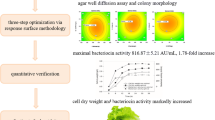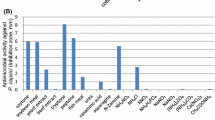Abstract
The influence of temperature, pH and media on bacteriocin production by Bacillus sp. P34 was investigated. The effect of temperature and initial pH was evaluated by factorial design and response surface methodology (RSM). Statistical analysis of results showed that, in the range studied, the two variables have a significant effect on bacteriocin production. Response-surface data showed maximum antimicrobial activity production at initial pH values between 6.0 and 8.0 and temperatures between 25 and 37 °C. No relationship between bacterial growth and bacteriocin production was observed. RSM proved to be a powerful tool in optimizing the production of antimicrobial activity by Bacillus sp. P34. When different media were tested, maximum bacteriocin production was observed in soybean protein-based medium, but antimicrobial activity was not achieved by cultivation on fish meal, feather meal, whey and grape waste.


Similar content being viewed by others
References
Amiali MN, Lacroix C, Simard RE (1998) High nisin Z production by Lactococcus lactis UL719 in whey permeate with aeration. World J Microbiol Biotechnol 14:887–894
Bizani D, Brandelli A (2004) Influence of temperature and pH on bacteriocin production by Bacillus cereus. Appl Microbiol Biotechnol 65:158–162
Cladera-Olivera F, Caron GR, Brandelli A (2004) Bacteriocin production by Bacillus licheniformis P40 in cheese whey using response surface methodology. Biochem Eng J 21:53–58
Cleveland J, Montville TJ, Nes IF, Chikindas ML (2001) Bacteriocins: safe, natural antimicrobials for food preservation. Int J Food Microbiol 71:1–20
De Vuyst L (1995) Nutritional factors affecting nisin production by Lactococcus lactis subsp.lactis NIZO 22186 in a synthetic medium. J Appl Bacteriol 78:28–33
De Vuyst L, Callewaert R, Crabbé K (1996) Primary metabolite kinetics of bacteriocin biosynthesis by Lactobacillus amylovorus and evidence for stimulation of bacteriocin production under unfavourable conditions. Microbiology 142:817–827
Dominguez APM, Bizani D, Cladera-Olivera F, Brandelli A (2007) Cerein 8 production in soybean protein using response surface technology. Biochem Eng J 35:238–243
Guerra NP, Pastrana L (2001) Enhance nisin and pediocin production on whey supplemented with different nitrogen sources. Biotechnol Lett 23:609–612
Guerra NP, Pastrana L (2002) Production of bacteriocins from Lact. Lactis. subsp. lactis CECT 539 and Pediococcus acidilactici NRRL B-5627 using mussel-processing wastes. Biotechnol Appl Biochem 36:119–125
Kim WS, Hal RJ, Dunn NW (1997) The effect of nisin concentration and nutrient depletion on nisin production of Lactococcus lactis. Appl Microbiol Biotechnol 50:429–433
Kimura H, Sashihara T, Matsusaki H, Sonomoto K, Ishizaki A (1998) Novel bacteriocin of Pediococcus sp. ISK-1 isolated from well-aged bed of fermented rice bran. Ann NY Acad Sci 864:345–348
Krier F, Revol-Junelles AM, Germain P (1998) Influence of temperature and pH on production of two bacteriocins by Leuconostoc mesenteroides subsp. mesenteroides FR52 during batch fermentation. Appl Microbiol Biotechnol 50:359–363
Leal-Sánchez MV, Jiménez-Díaz R, Maldonado-Barragán A, Garrido-Fernández A, Ruiz-Barba JL (2002) Optimization of bacteriocin production by batch fermentation of Lactobacillus plantarum LPCO10. Appl Environ Microbiol 68:4465–4471
Leroy F, De Vuyst L (2002) Bacteriocin production by Enterococcus faecium RZS C5 is cell density limited and occurs in the very early growth phase. Int J Food Microbiol 72:155–164
Li C, Bai J, Cai Z, Ouyang F (2002) Optimization of a cultural medium for bacteriocin production by Lactococcus lactis using response surface methodology. J Biotechnol 93:27–34
Mataragas M, Metaxopoulos J, Galiotou M, Drosinos EH (2003) Influence of pH and temperature on growth and bacteriocin production by Leuconostoc mesenteroides L124 and Lactobacillus curvatus L442. Meat Sci 64:265–271
Messens W, Verluyten J, Leroy F, De Vuyst L (2003) Modelling growth and bacteriocin production by Lactobacillus curvatus LTH 1174 in response to temperature and pH values used for European sausage fermentation processes. Int J Food Microbiol 81:41–52
Motta AS, Brandelli A (2002) Characterization of an antibacterial peptide produced by Brevibacterium linens. J Appl Microbiol 92:63–71
Motta AS, Brandelli A (2003) Influence of growth conditions on bacteriocin production by Brevibacterium linens. Appl Microbiol Biotechnol 62:163–167
Motta AS, Cladera-Olivera F, Brandelli A (2004) Screening for antimicrobial activity among bacteria isolated from Amazon basin. Braz J Microbiol 35:307–310
Motta AS, Lorenzini DM, Brandelli A (2007) Purification and partial characterization of an antimicrobial peptide produced by a novel Bacillus sp. strain isolated from Amazon basin. Curr Microbiol 54:282–286
Myers R, Montgomery RC (2002) Response surface methodology: process and product optimization using designed experiments. Wiley, New York
Olson ER (1993) Influence of pH on bacterial gene expression. Mol Microbiol 8:5–14
Parente E, Ricciardi A, Addario G (1994) Influence of pH on growth and bacteriocin production by Lactococcus lactis subsp. lactis 140NWC during batch fermentation. Appl Microbiol Biotechnol 41:388–394
Vázquez JA, González MP, Murado MA (2006) Preliminary tests on nisin and pediocin production using waste protein sources factorial and kinetic studies. Bioresor Technol 97:605–613
Zalán Z, Németh E, Baráth A, Halasz A (2005) Influence of growth medium in hydrogen peroxide and bacteriocin production of Lactobacillus strains. Food Technol Biotechnol 43:219–225
Acknowledgement
This work was supported by CAPES and CNPq, Brazil.
Author information
Authors and Affiliations
Corresponding author
Rights and permissions
About this article
Cite this article
Motta, A.S., Brandelli, A. Evaluation of environmental conditions for production of bacteriocin-like substance by Bacillus sp. strain P34. World J Microbiol Biotechnol 24, 641–646 (2008). https://doi.org/10.1007/s11274-007-9520-6
Received:
Accepted:
Published:
Issue Date:
DOI: https://doi.org/10.1007/s11274-007-9520-6




